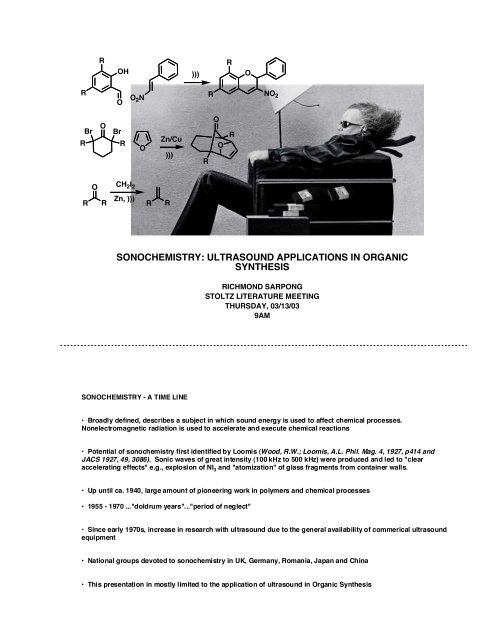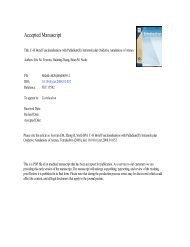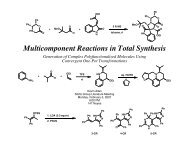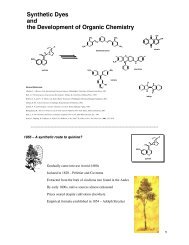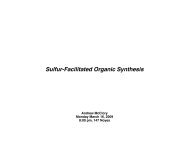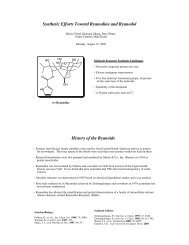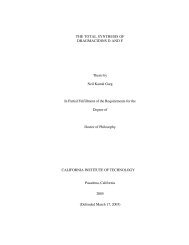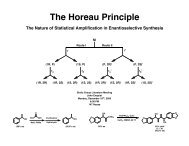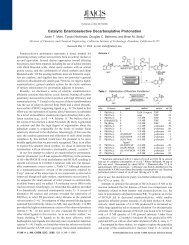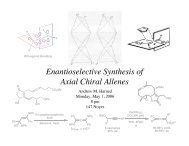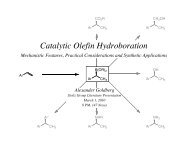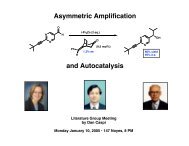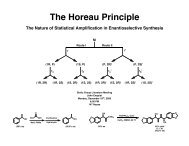sonochemistry: ultrasound applications in organic ... - The Stoltz Group
sonochemistry: ultrasound applications in organic ... - The Stoltz Group
sonochemistry: ultrasound applications in organic ... - The Stoltz Group
You also want an ePaper? Increase the reach of your titles
YUMPU automatically turns print PDFs into web optimized ePapers that Google loves.
DEFINING THE LAWS OF SONOCHEMISTRYA specific nature of <strong>sonochemistry</strong> is suggested Ando etal JCSCC, 1984, p439BrKCN/Al 2 O 3CN83% 76%+ regioisomersSTIRREDSONOLYSEDSonication seems to obey some rules of its own• An empirical systemization of <strong>sonochemistry</strong> has been published (Luche, J.L. Advances <strong>in</strong> Sonochemistry, Vol3,1993, p 85 and TL, 1990, 4125)• Effects are both chemical and mechanicalRULE 1Reactions that proceed via radical or radical ion <strong>in</strong>termediates are most likely to be sonochemically <strong>in</strong>fluencedRULE 2In heteregenous systems, reactions proceed<strong>in</strong>g via ionic <strong>in</strong>termediates can be stimulated by mechanical effects.Usually the effect is comparable to efficient mix<strong>in</strong>gRULE 3Heterogenous reactions with mixed mechanisms (radical and ionic). <strong>The</strong>se may be enhanced <strong>in</strong> a convergent way(chemically for the radical and mechanical for the ionic) or a switch may occur where the radical pathway is enhancedand "change" the reaction productsFactors affect<strong>in</strong>g sonochemical reactions: frequency, power, reaction temperature (low temperature can lead tohigher reaction rates!), overpressure, solventSONOCHEMICAL REACTIONS IN ORGANIC SYNTHESISHOMOGENOUS REACTIONS - Have received less attention for sonochemical activationK<strong>in</strong>etic StudiesON 3)))N C OPorter etal. JACS, 1938, 1497Enhanced <strong>in</strong>itial rateHydrolysisO 2 NOOR+H 2 O)))35 o CROOH+O 2 NOHKristol etal. TL, 1981,90714-15% enhancement<strong>in</strong>dependentof R group(CH 3 ) 3 C-ClH 2 O/ Ethanol)))(CH 3 ) 3 C-OH+ HClMason etal. Ultrasonics Int. '85Proc., Butterworth, U.K., 839• Effect of <strong>ultrasound</strong> <strong>in</strong>creased with EtOH content with a maximum effect at 50% w/w• Rates of reaction under sonolysis <strong>in</strong>creased as temp was reduced from 20 o C to 10 o C
Sonolysis of some solvents may occur: H 2 O, CCl 4 , CHCl 3 . We can take advantage of this <strong>in</strong> synthesisSonoisomerizationCO 2 MeR• X•CO 2 Me- X•MeO 2 CElp<strong>in</strong>er etal. Nature, 1965, 945CO 2 Me)))XCO 2 MeCO 2 MeR-XA Variation of the Hunsdiecker Reaction (Dauben etal. JOC, 1989, 6101)NOSROCl 3 C• X•)))10 - 15 m<strong>in</strong>, 33 o CCl 3 C-XNSCCl 3 + CO 2+R•X•R-ClCleavage of the T<strong>in</strong> Hydrogen bondOHOIPhR 3 SnHO 2))) 0-20 o COPhNakamura, E. JACS, 1991, 898084%<strong>The</strong> radical nature of some reactions is compromised by attached R groupsHOPOROR+R'R'NR')))R'R'R'HNOPOR ORHubert C. etalJOC, 1995, 1488>90% yield <strong>in</strong> 1.5 h w/ R = EtNo rate enhancement w/ R = C 16 H 31Sonolysis of Iron CarbonylsOOOHFe 2 (CO) 9)))23 o C, 30 m<strong>in</strong>(OC) 3 FeO60 atm COOOLey, S.V etal.J. Organomet. Chem.1985, C17, 28570%Milder Conditions, Enhanced Rates for the Heck Reaction (Cheng, J etal. Bull. Inst. Chem. Acad. S<strong>in</strong>. 1989, 9)ICO 2 MePd(PPh 3 ), NEt 3CH 3 CN, C 6 H 6CO 2 Me50 o C, 6h, 76% (sonication)80 o C, 24h, 71% (thermal)Pauson-Khand Annulation is Accelerated by Sonication (J. Organomet. Chem. 1988, 233)OCo(CO) 3HCo(CO) 3+OBu 3 PO, hexane)))Ph
CARBON-CARBON BOND FORMATIONHorner-Wadsworth-WittigO H 3 CO 2 SOPORORCH 3))) THF, 23 o CSO 2 CH 3CH 370-80%
Saponifications <strong>in</strong> Aqueous Solutions are Enhanced by Ultrasound; Sonochemical EmulsificationOOMe10% aq. NaOHOOHTL, 1979, 3917Reflux, 90 m<strong>in</strong>, 15%Sonication, 23 o C, 96%Formation of anions from heterogenous bases facilitated by sonicationSONaH,)))50 o C, 1h SNaTL, 1966, 6383OCNCO 2 EtBrBrK 2 CO 3, )))PEG-600, ClCH 2 CH 2 ClCNCO 2 EtCh<strong>in</strong>. Chem. Lett. 1991, 517Chem. Abstr. 1992, 116, 193753t85%Nitrogen Protection (Under Phase Transfer Catalysis) Is Enhanced. This is also true for <strong>in</strong>dole protection.NHOH(t-BuOCO) 2 O, NaHCO 3MeOH, ))), 3hNCOOt-BuOHLuche, J.L. etal. Synlett, 1991, 37>80% yieldA Case for "C-H Functionalization"? (JCSCC, 1994, 1425)SiNaNO 2 , AcOHCe(NH 4 ) 2 (NO 3 ) 6CHCl 3 , 23-75 o C))), 4hSiNO 2[O]Si+HNO 2SiNO2REDUCTION REACTIONSMeOBrLAH, DME))), 35 o C, 7hMeO70%Boudjouk etal. TL, 1982, 1643OSiOMeLiAlD 4 , C 6 D 12))), 25 o C, 2hOSiDTL, 1984, 1415• <strong>The</strong> usual reductive protocols <strong>in</strong>volv<strong>in</strong>g heterogenous systems are also facilitated(e.g., nitro to am<strong>in</strong>e, aldehyde to alcohol etc)• Generally, sonochemical reduction chemistry is underexplored
OXIDATION REACTIONSPerfluoroalkylO 2 , Sulfonate salt)))OHMokryi, E.N etal. Akad. Nauk Ukr. 1993, 7, 99Chem. Abstr. 1994, 121, 107751KMnO 4 , H 3 O +PhH,450 torr)))OJCS Perk<strong>in</strong> Trans. II, 1988, 375HORRTPAP, NMO25 o C, 90 m<strong>in</strong>O>90%RORTL, 1991, 3201OHPCC/SiO 220 m<strong>in</strong>, )))OJOC, 1989, 5387ORGANOMETALLIC SONOCHEMISTRY•This has seen the greatest impact <strong>in</strong> terms of sonochemical <strong>applications</strong>•Usually, the <strong>in</strong>fluence of <strong>ultrasound</strong> is to remove passivat<strong>in</strong>g coat<strong>in</strong>gs on metals (oxides, carbonates, OH etc) -->Depassivation and also to aid <strong>in</strong> s<strong>in</strong>gle electron transfer processes which constitute a crucial step <strong>in</strong> the formation oforganometallic compounds•Recently Reviewed: Luche, J.L.; C<strong>in</strong>tas, P. (Furstner, A. (ed.)), Activated Metals, VCH, We<strong>in</strong>heim, 1997.ALKALI METALS AND MAGNESIUMBogdanovic etal. ACIEE, 1983, 728+ Mg))) )))+Mg*Acylo<strong>in</strong> Condensation (SynLett, 1990, 89)CO 2 EtMe 3 SiCl, Na, THFMgOSiMe 3Activated Mg* is useful forGrignard reagent prepSONICATION IS GENERALLY USEFULFOR GRIGNARD REACTIONS, HALOGEN-METAL AND TRANSMETAL EXCHANGESCO 2 Et0 o C, 2 h, ))), 82%OSiMe 3OHO90%, <strong>The</strong>rmalNR 2Li, THFOTL, 1988, 218390%, Sonochemical
• Historically, the first metal to be used <strong>in</strong> <strong>organic</strong> chemistryREACTIONS WITH ZINC METAL• Zn-mediated reactions have been the most extensively studied <strong>in</strong> sonochemical organometallic chemistryREDUCTIONS<strong>The</strong> Zn(Ni) Couple (Luche, J.L. etal. JOC, 1989, 5313OZn(Ni) (9:1)EtOH, H 2 OOZn(Ni) (9:1)EtOH, H 2 OO95 %NH 3 -NH 4 ClpH 8,))), 1.5 h23 o C))), 3 h, 23 o C96 %<strong>The</strong>rmal (12 h, 90 %) <strong>The</strong>rmal (24 h, 90 %)TL, 1993, 1993, 357OOOZn, AcOH, 25 o C10 m<strong>in</strong>, 100 %)))H5!:5" =1.5:1ORGANOZINC REAGENTSImproved Simmons-Smith Protocol (TL, 1982, 2729)Zn, CH 2 I 2 , DME4h, 90 o C,)))67% (12 % <strong>The</strong>rmally)Unpredictable <strong>in</strong>duction period suppressedHydroperfluoroalkylation/ Carbometallation (JACS, 1985, 5186)CF 3 I+HOZn, CuI, THFF 3 C23 o C, 2 h, ))) 61 %OHBarbier-Type Processes (Boudjouk etal. JOC, 1982, 751)BrBrRR'Zn, Dioxane)))67-89%RRNo Reaction <strong>The</strong>rmally!R is electron withdraw<strong>in</strong>g
REFORMATSKY REACTION• Significant rate and yield improvements have been observedMeyers, A.I. JOC, 1991, 2091NOZn(Ag), THFNONRNCBr40 o C, ))), 2 hNR84 %NH 2Jackson etal. JOC, 1992, 3397INHBOCCOOBnZn(Cu), )))DMA, PhH, 30 m<strong>in</strong>IZnNHBOCCOOBn(Ph 3 P) 2 PdCl 2 , )))NNHBocCOOBnNBr• Sn and In seem to predom<strong>in</strong>ateAQUEOUS ORGANOMETALLIC COUPLINGSWhitesides, G.M. JOC, 1993, 5500Aq. CH 2 O +BrSn, aq. NH 4 Cl-THF23 o C, 1 h, )))HO60 %B<strong>in</strong>der etal. Tetrahedron, 1994, 749HOHOOOHOHAllylBr, Sn, )))EtOH-H 2 O (10:1)OH OHOH OH OH60 - 65 %OOCHOAllylBr, In, )))EtOH, 1 hOOOH60 %
OTHER METALS FOR ORGANOMETALLIC SONOCHEMISTRYCu for Ullmann Coupl<strong>in</strong>gs (Mason etal. Ultrasonics, 1986, 292)NO 2NO 2ONO 2Cu, DMFI))), 60 o C, 90 m<strong>in</strong>95 %Al for Reduction Chemistry (TL, 1993, 353)OHOHOOAl(Hg),10 % aq. HCOONaEtOH, 23 o C, )))OHHOHO80 %(<strong>The</strong>rmally 23 %)CONCLUSIONS• Sonochemistry is ga<strong>in</strong><strong>in</strong>g significance based on laboratory results and the availability of scale-up systems• Sonochemical <strong>applications</strong> can be envisaged <strong>in</strong> all types of systems, <strong>in</strong>clud<strong>in</strong>g homogenous reactions• Wide acceptance has been ga<strong>in</strong>ed at a practical/empirical level, however, the theoretical understand<strong>in</strong>g still lagssignificantly beh<strong>in</strong>d• <strong>The</strong> usefulness of <strong>sonochemistry</strong> cont<strong>in</strong>ues to expand <strong>in</strong>to the arena of electrochemistry, photochemistry andbiotechnology• FOR THE ORGANIC CHEMIST: WHEN IN DOUBT, SONICATE!!!!!Useful referencesPrice, G.J. (ed.)., Current Trends <strong>in</strong> Sonochemistry, Royal Society of Chemistry, Oxford, 1993Mason, T.J. (ed.), Chemistry With Ultrasound, Elsevier Applied Science, London, New York, 1990van Eldik, R.; Hubbard, C.D. (eds.), Chemistry Under Extreme or Non-Classical Conditions, Spektrum/Wiley, 1997Abdulla, R.F. Adrichimica Acta 21, 1988, 31 - 42


